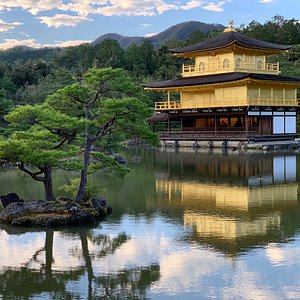If you’re planning a trip to Japan, visiting Fushimi Inari-taisha Shrine in Kyoto is a must. As the top-ranked attraction in Kyoto on TripAdvisor, this shrine is not to be missed. Fushimi Inari-taisha Shrine is dedicated to Inari, the Shinto god of rice, and is one of many shrines in Japan that pay homage to this deity.

Table of Contents
Attractions and Tours
Aside from the shrine itself, there are plenty of other attractions nearby, such as Kinkakuji Temple, Nijo Castle, and Gion. You can explore these attractions through various tours and activities, including private and customizable tours, outdoor activities, cultural and theme tours, and more.
Visiting Fushimi Inari-taisha Shrine
The shrine is open 24/7, making it easy to fit into your schedule no matter what time you visit. You can take your time exploring the historic and religious sites of the shrine, including the famous torii gates that lead up to Mount Inari. Don’t forget to snap a few photos along the way to remember your visit.
Overall, Fushimi Inari-taisha Shrine is a must-visit destination for anyone traveling to Kyoto. With so much to see and do in the area, you won’t be disappointed.
History and significance of Fushimi Inari-taisha Shrine
Origins of the shrine and its connection to the Shinto god Inari
As you explore Fushimi Inari-taisha Shrine, you’ll learn that it has a storied history and plays an important role in Japanese culture and religion. The shrine was founded in the 8th century and is dedicated to Inari, the Shinto god of rice, fertility, and foxes. Inari is revered as the patron of agriculture and business, making the shrine popular with farmers and merchants.
Significance of the shrine in Japanese culture and religion
Visiting Fushimi Inari-taisha Shrine will give you a better understanding of Japanese culture and religion. The shrine’s significance extends beyond its religious and agricultural roots – it also holds a special place in Japanese folklore. According to legend, Inari’s messengers, foxes, provide good fortune and protect the faithful.
Exploring the shrine’s numerous torii gates and pathways can be meditative and inspiring. The shrine complex is also a window into Japanese history and architecture, with ornate wooden buildings and traditional gardens.
Overall, Fushimi Inari-taisha Shrine is an experience not to be missed during your visit to Kyoto. Its unique history and cultural significance make it a must-see destination for any traveler.

Exploring Fushimi Inari-taisha Shrine in Kyoto
When you visit Kyoto, one spot that should be on your itinerary is the Fushimi Inari-taisha Shrine, a historic and religious site that is open 24/7. It is a shrine that honors Inari, the Shinto god of rice and is one of the many shrines in Japan that do so.
The Fushimi Inari-taisha Shrine is the most popular tourist attraction in Kyoto and is ranked #1 of 2,000 things to do on TripAdvisor. Various tours and experiences are available for visitors, ranging from private and custom tours to outdoor activities, cultural and theme tours, and more.
Overview of the shrine’s layout and architecture
The shrine features impressive architecture, including dragon and fox statues and a grand main shrine hall built in 1499. As you explore the grounds, you will also come across smaller inari shrines and beautiful gardens.
Main attractions within the shrine grounds
You will find many attractions within the shrine grounds, including a traditional Japanese vermilion gate and statues of foxes, Inari’s messengers. You will also find a fortune-telling machine and water basin where you can cleanse your hands and mouth before praying.
Hiking the famous torii gates to the Mount Inari summit
Perhaps the most famous attraction of the Fushimi Inari-taisha Shrine is the hiking trail that leads to the summit of Mount Inari. This hike will take you through thousands of torii gates, each donated by individuals or companies in hopes of receiving Inari’s blessing for their business or endeavors.
When visiting Kyoto, you should not miss out on the Fushimi Inari-taisha Shrine and its wonders. Other popular attractions nearby include Kinkakuji Temple, Nijo Castle, Gion, Arashiyama, and more, all of which can be explored through various tours and activities.

Tours and experiences
Private and custom tours of the shrine
If you want a personalized experience when visiting Fushimi Inari-taisha Shrine, consider taking a private or custom tour. These tours, which can be booked in advance, allow you to explore the shrine at your own pace and ask any questions you may have to an expert guide. It’s a great option if you want to learn more about the history and significance of the shrine.
Outdoor activities like hiking and nature walks
For more active visitors, there are outdoor activities available at the shrine, such as hiking and nature walks. You can enjoy the beautiful scenery surrounding the shrine while getting a good workout. Many trails are available for hiking, and some of them lead to hidden temples and shrines.
Cultural and theme tours
If you’re interested in Japanese culture, you may want to consider taking a cultural or theme tour of the shrine. These tours can focus on topics such as Japanese art, religion, or history, and provide a unique perspective on the shrine. You may even get the chance to participate in a traditional tea ceremony or wear a kimono.
No matter what kind of experience you’re looking for, there are plenty of tours and activities available at Fushimi Inari-taisha Shrine to help you get the most out of your visit.

Nearby attractions
If you’re planning a trip to Fushimi Inari-taisha Shrine in Kyoto, you’ll have plenty of other popular attractions to explore in the area. Two of the most well-known sites are Kinkakuji Temple and Nijo Castle. Kinkakuji Temple, also known as the Golden Pavilion, is a stunning temple covered in gold leaf. Meanwhile, Nijo Castle is a UNESCO World Heritage Site that dates back to the 17th century.
In addition to these historic sites, the Gion district is a must-visit destination for anyone interested in Japanese culture. It’s especially famous for the geiko (geisha) and maiko (apprentice geisha) who can often be spotted in the area. For a more natural setting, check out Arashiyama, a district known for its bamboo groves, temples, shrines, and scenic river views.
Of course, there are plenty of other areas to explore as well, including museums, parks, and shopping districts. With so many options, you might want to consider a tour or activity that covers multiple sites. There are numerous customizable options available for visitors, allowing you to choose the experiences that are perfect for you.
Tips for Visiting Fushimi Inari-taisha Shrine in Kyoto
Best times to visit the shrine to avoid crowds
You’ll want to avoid peak tourist times to enjoy Fushimi Inari-taisha Shrine in a more tranquil setting. The shrine is open 24/7, so visiting early in the morning or after sunset will help you avoid crowds. The best time for photography is at sunset as the orange hues illuminate the pathways and torii gates.
Cultural customs and etiquette to observe
When visiting the shrine, it’s important to observe cultural customs to show respect for the religion and its history. You’ll need to remove your shoes before entering the inner shrine, and you should never step on the thresholds. It’s also important to dress modestly and avoid loud conversations.
Practical information for visitors
Be prepared for a lot of walking as you hike through the 4 km trail full of thousands of torii gates. Wear comfortable shoes and bring water as it can get hot in the summertime. If you’re planning on visiting other nearby attractions such as Kinkakuji Temple or Nijo Castle, consider purchasing a Kyoto sightseeing pass to save money on transportation.
Explore the Cultural and Religious Significance of Fushimi Inari-taisha Shrine
Visiting Fushimi Inari-taisha Shrine should be at the top of your list when exploring Kyoto. Ranked #1 out of 2,000 things to do in Kyoto on TripAdvisor, the shrine is steeped in rich culture, history, and religion. You can explore the stunning vermilion gates that line the mountain trails or indulge in the numerous tours and activities available for visitors, which include private and custom tours, outdoor activities, cultural, and theme tours.
Other Attractions to Explore
Apart from the Fushimi Inari-taisha Shrine, there are other attractions to explore nearby in Kyoto. Some of the popular attractions include Kinkakuji Temple, Nijo Castle, Gion, Arashiyama, among others.
Visit at Any Time of the Day
Located in Kyoto, the Fushimi Inari-taisha Shrine is open 24/7 to visitors to explore its historic and religious sites. This shrine is one of many shrines in Japan that honors Inari, the Shinto god of rice. Take some time to experience the cultural and religious significance of the shrine, and you will be captivated by its beauty and history.

Resources
Official website of Fushimi Inari-taisha Shrine
You can visit the official website of the Fushimi Inari-taisha Shrine for more information about the shrine’s history, events, and offerings. The website is available in multiple languages for visitors’ convenience.
TripAdvisor reviews and ratings
Ranked #1 of 2,000 things to do in Kyoto on TripAdvisor, Fushimi Inari-taisha Shrine is a must-visit attraction for tourists. You can check out TripAdvisor’s reviews and ratings for the shrine to learn more about visitors’ experiences and tips.
Information on nearby tours and activities
Apart from exploring Fushimi Inari-taisha Shrine, you can visit other popular attractions nearby, including Kinkakuji Temple, Nijo Castle, and Gion, among others. There are various tours and activities available for visitors, such as private and custom tours, cultural and theme tours, and outdoor activities. You can research and book these tours and activities online or with a local tour agency.
Fushimi Inari-taisha Shrine is located in Kyoto and is open 24/7 for tourists to explore its historic and religious sites. As you plan your trip to Kyoto, be sure to check out these resources to make the most of your visit.
Exploring Fushimi Inari-taisha Shrine is an unforgettable experience that’s worth the trip to Kyoto. Remember to observe the cultural customs, wear comfortable shoes, and avoid peak tourist times to get the most out of your visit.
